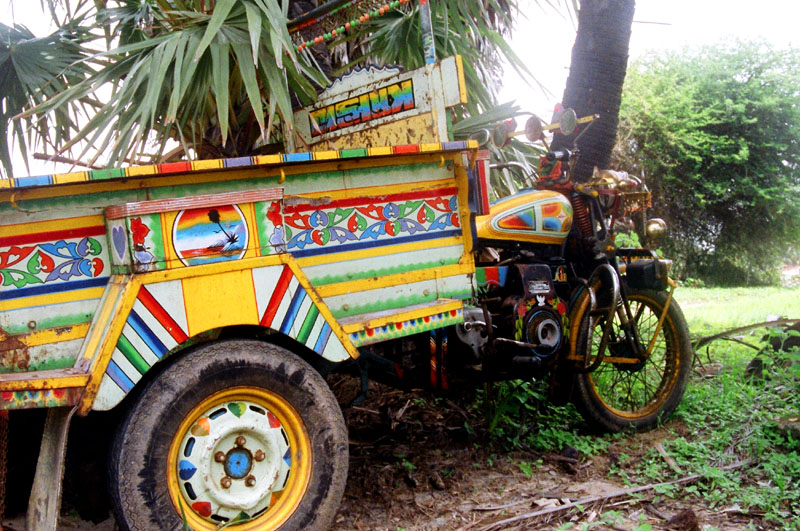
I've been busy at work these last couple of weeks so I haven't been able to spend as much time here as I would've liked to. But I've been scanning old films, some new ones, processing some pictures and I think I've put together enough material to last me another week or so. So tonight I'll post something that's very close to my heart.
______
Tuk-tuks (or chhakdas as they are known in some parts of India), motorcycle bodies mated to a large wooden carrier, are mostly ubiquitous all over the country. Especially so in the more rural areas. They are seen as a cheap alternative to mainstream transportation, and small enough to maneuvre easily on the tiny, winding country roads. Almost all are characterised by intricately painted patterns in bright, often psychedelic, colours. To most Indians the garish designs come across as loud and crass. Nonetheless they seem to be a favourite with those in the 'transportation' industry, since the 'shout-out' colours are a recurring theme even on other mass transport vehicles such as buses, trucks and autorickshaws- not just in India but all over the south and south-east Asian region. And sometimes it takes an outsider to get us to appreciate something that we find repulsive, yet is an integral part of the social fabric.
During the late 1960s and early 1970s Ettore Sottsass, the Italian architect turned industrial designer, made several visits to India as part of the UNDP cultural exchange program. A professor of mine from design school, then a much younger man, travelled with him through parts of northern and central India and they spent long hours discussing the aesthetic as typefied by trucks and tuk-tuks in this part of the world. A significant portion of the discussion focussed on Sottsass' dissatisfaction with the International Style prevalent then and the Post-Bauhaus black-box designs churned out in the US and Europe. He saw something in the irreverant humour and the gross aestheitc of tuk-tuks that we Indians had obviously missed.
A decade later, in 1981, Sottsass and a few associates launched the Memphis Group. Their work, touted by many as more fashion than academia, went a long way in breaking out of the black-box mould that design had gotten into post-Bauhaus. Characterised by bright colours, rich visual texture and a complete disregard for function or propriety, Memphis soon became a fashion statement. While the group disbanded in 1988, Memphis became a watershed period in the history of modern design.
And, as some of us in India like to believe, it all started here with the tuk-tuk.
______
Nikon F75, 28-105mm
Fuji 400ISO
2005, Diu, India



5 comments:
Colorful :-)
I am beginning to like the descriptions you put with your posts more than the pics themselves. Almost :)
Nice :)
Now that's what I call a taxi/bus! A lot more colourful than what we have here. Though I bet the drivers are as bad. ;-)
Hope work doesn't keep you from us for too long.
BRIGHT very Bright Colors,I like the yellow and the helicopter kind of thingy in the painting.
:-) are you a photographer??
Sahil, sorry for the confusion. I'm still at the usual address, I was testing out Pixelpost prior to using it on the main site. So, no need to worry or, change addresses or anything. Hope you liked the new look. :-)
Post a Comment